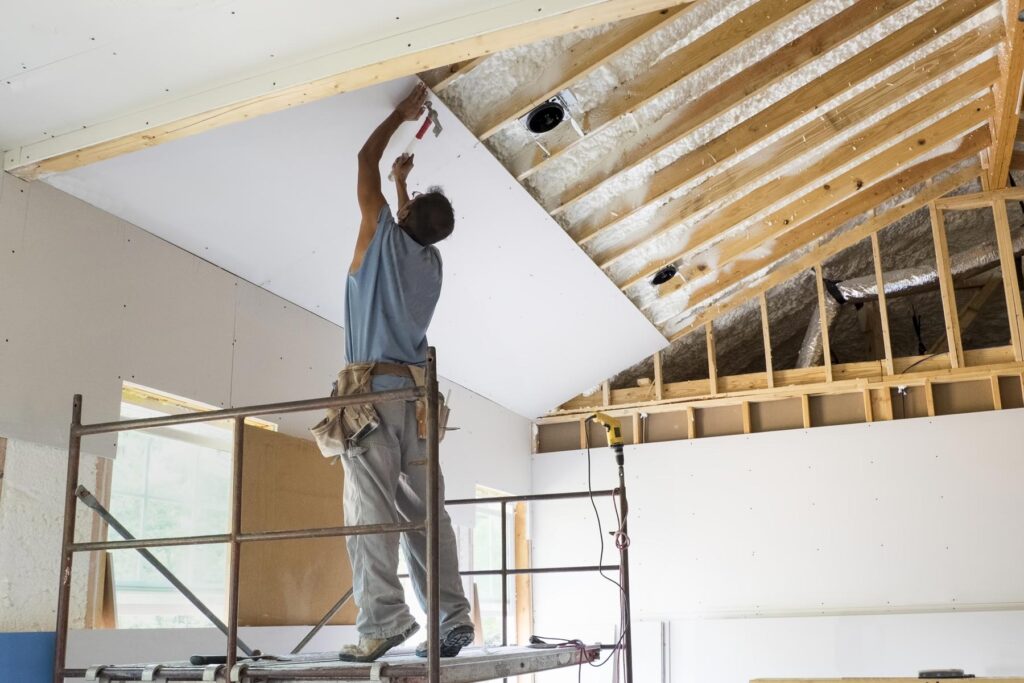Total Guide to Trustworthy and effective Drywall Installment
Drywall setup is a vital element of any building and construction or restoration task, demanding a precise approach to guarantee both efficiency and integrity. Understanding the essential tools and techniques is critical, as well as identifying typical risks that can result in substandard outcomes. By carefully preparing the room and carrying out best practices, one can attain a perfect coating that stands the examination of time. It is vital to check out the subtleties of each step in the procedure, as they jointly add to the total success of the drywall installment. What details methods can raise your approach?
Crucial Devices for Drywalling
When getting started on a drywall installation job, having the right tools is essential for attaining a specialist coating. Necessary tools include a drywall blade, measuring tape, and a T-square, which are essential for exact measurements and smooth cuts. A drywall lift is additionally extremely useful, specifically for ceiling installations, permitting much easier handling of hefty panels.
For attaching the drywall, a cordless drill and drywall screws are required. The drill should be outfitted with a drywall little bit to make sure effectiveness and accuracy. In addition, a crucial device is the drywall saw, which facilitates cutting around various other obstacles and electric outlets.

Additionally, safety equipment such as safety glasses and a dirt mask are important to ensure personal safety throughout the installment procedure. Utilizing the right devices not only enhances the top quality of the installment but also enhances the workflow, making the job more reliable overall.
Preparing the Room

Following, assess the problem of the wall surfaces and ceilings. Repair any kind of existing damage, such as holes, fractures, or peeling off paint, to make sure a smooth and even surface area for drywall application. Additionally, check for electric outlets, plumbing lines, and heating and cooling air ducts, noting their places to prevent difficulties during installation.
It is additionally critical to measure the space properly, figuring out the dimensions of the walls and ceilings to compute the appropriate quantity of drywall needed. Develop an in-depth plan that consists of the layout and positioning of the drywall panels.
Setup Techniques
Reliable installment techniques are crucial for attaining a specialist surface in drywall jobs. Appropriate measurement and cutting of drywall sheets are fundamental actions.
When hanging drywall, begin with the leading and job downward, guaranteeing that the lengthy edge of the board is vertical to the framing. Secure the sheets with screws instead of nails, which supply better holding power and decrease the danger of standing out. Location screws every 12 inches along the edges and every 16 inches in the field of the board.
For corners, utilize corner beads to achieve sharp, tidy edges. When installing on ceilings, utilize a drywall lift or have a partner assist in holding the sheets in place (drywall contractor). Maintain a void of about 1/4 inch over the floor and ceiling to fit expansion and tightening
Ending Up Touches

Begin by using joint tape over the joints. This can be either paper or fiberglass mesh tape, with paper being favored for its sturdiness. Once the tape remains in area, it's time to apply the very first coat of joint substance, also referred to as mud. Use a 10 to 12-inch taping blade to spread the compound uniformly over the taped joints, feathering the edges to blend with the bordering drywall.
Allow the compound to dry thoroughly, usually 1 day. After drying out, sand the surface area lightly with fine-grit sandpaper to eliminate any kind of blemishes. sheetrock repair fort worth. Repeat the mudding and fining sand procedure, typically 2 to 3 coats, making certain each layer is flush and smooth with the drywall surface area
Usual Blunders to Prevent
Several Do it yourself lovers come across challenges throughout drywall setup that can jeopardize the last outcomes. One typical blunder is failing to correctly determine and reduce drywall sheets.
An additional regular mistake is incorrect fastening. Making use of too couple of screws or nails can bring about loose drywall, while overdriving fasteners can create the paper to tear, compromising the framework. It's important to maintain consistent spacing, generally every 16 inches, and to make certain that bolts are flush with the surface area.
Additionally, not dealing with dampness problems before installment can lead to mold and mildew growth and architectural damages. Constantly assess the atmosphere and use moisture-resistant drywall in high-humidity locations.
Conclusion
Dependable and effective drywall installment requires precise focus to information throughout the process. see this Preventing usual blunders further contributes to an expert outcome, emphasizing the significance of precision and method in effective drywall tasks.
It is essential to check out the nuances of each action in the procedure, as they jointly add to the total success of the drywall installation.When embarking on a drywall installation job, having the right tools is vital for attaining a professional finish.For fastening the drywall, a cordless drill and drywall screws are additional hints required.Correctly preparing the area is necessary for an effective drywall installment.Reliable installment strategies are essential for attaining a professional finish in drywall projects.
Comments on “Economical Drywall Repair Options for Your Fort Worth Residential Property”